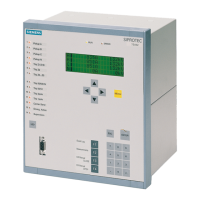Set to Disabled to disable the entire time overcurrent protection.
The directional overcurrent protection 67(N) is set at address 115 67/67-TOC and 116 67N/67N-TOC. Here,
the same options are available as for non-directional overcurrent protection (except the 50-3 element).
For (sensitive) ground fault detection address 130 S.Gnd.F.Dir.Ch lets you specify the directional charac-
teristic of the sensitive ground fault detection. You can select between cos φ / sin φ and V0/I0 φ mea.
as the measurement procedure. The cos φ / sin φ procedure (via residual wattmetric current detection) is
set by default.
If the measuring method cos φ / sin φ is set, select between a definite time characteristic (Definite
Time) and an inverse time characteristic User Defined PU at address 131 Sens. Gnd Fault. V0/I0 φ
mea. provides the definite time characteristic Definite Time, inverse time characteristics TOC IEC or TOC
ANSI. When selecting the setting Disabled, the entire function is disabled.
For the intermittent ground fault protection, you can specify the measured quantity (with Ignd, with 3I0
or with Ignd,sens.) to be used by this protection function at address 133 INTERM.EF.
At address 134 Dir. Interm. EF you can set the directional intermittent ground fault protection to
Enabled or Disabled.
For unbalanced load protection, address 140 46 allows you to specify which tripping characteristics to use.
You can select between Definite Time, TOC ANSI or TOC IEC. If this function is not required, select
Disabled.
The overload protection is activated in address 142 49 by selecting the setting without ambient temperature
No ambient temp or it is set to Disabled.
At address 155 27/Q-Protection you can set the QU protection to Enabled or Disabled.
The synchronization function is activated in address 161 25 Function 1 by the setting SYNCHROCHECK or it
is set to Disabled.
In address 170 you can set the breaker failure protection to Enabled or Disabled. The setting option
enabled w/ 3I0> subjects the ground current and the negative sequence current to a plausibility check.
For the CB maintenance functions, several options are available under address 172 52 B.WEAR MONIT. Irre-
spective of this, the basic functionality of the summation current formation (ΣΙ procedure) is always active. It
requires no further configurations and adds up the tripping currents of the trips initiated by the protection
functions.
When selecting the ΣI
x
-Procedure, the sum of all tripping current powers is formed and output as reference
value. The 2P Procedure continuously calculates the remaining lifespan of the circuit breaker.
With the Ι
2
t Procedure the square fault current integrals are formed via arc time and output as a reference
value.
Further information concerning the individual procedures of the CB maintenance are given in
Section2.23.2 Statistics. You can also disable this function by setting it to Disabled.
In address 181, you can enter how many line sections (maximum of three) are taken into account by the fault
locator.
Under address 182 74 Trip Ct Supv it can be selected whether the trip-circuit supervision works with two
(2 Binary Inputs) or only one binary input (1 Binary Input), or whether the function is configured
Disabled.
In address 617 ServiProt (CM) you can specify for which purpose port B is used. T103 means that the
device is connected to a control and protection facility via serial port, DIGSI means that you are using the
port to connect DIGSI or you are not using port B (Disabled).
The flexible protection functions can be configured via parameter FLEXIBLE FUNC.. You can create up to 20
flexible functions by setting a checkmark in front of the desired function (an example is given in the Section
2.19 Reverse-Power Protection Application with Flexible Protection Function). If the checkmark of a function is
removed, all settings and configurations made previously will be lost. After re-selecting the function, all
settings and configurations are in default setting. Setting of the flexible function is done in DIGSI under
“Parameters”, “Additional Functions” and “Settings”. The configuration is done, as usual, under “Parameters”
and “Masking I/O (Configuration Matrix)”.
Functions
2.1 General
SIPROTEC 4, 7SJ80, Manual 31
E50417-G1140-C343-A8, Edition 12.2017

